Draco is one of the largest constellations in the sky. Located in the northern celestial hemisphere, the constellation represents Ladon, the dragon that guarded the gardens of the Hesperides in Greek mythology. The name Draco means “the dragon” in Latin.
Draco is one of the Greek constellations. It was first catalogued by the Greek astronomer Ptolemy in the 2nd century. It is a circumpolar constellation; it never sets below the horizon for many observers in the northern hemisphere.
Draco contains several famous deep sky objects. These include the Cat’s Eye Nebula (NGC 6543), the Spindle Galaxy (Messier 102, NGC 5866), and the Tadpole Galaxy.
Facts, location and map
Draco is the eighth largest constellation in the night sky, occupying an area of 1083 square degrees. It lies in the third quadrant of the northern hemisphere (NQ3) and can be seen at latitudes between +90° and -15°. The neighboring constellations are Boötes, Camelopardalis, Cepheus, Cygnus, Hercules, Lyra, Ursa Major, and Ursa Minor.
The constellation name Draco is pronounced /ˈdreɪkoʊ/. In English, the constellation is known as the Dragon. The genitive form of Draco, used in star names, is Draconis (pronunciation: /drəˈkoʊnɪs/). The three-letter abbreviation, adopted by the International Astronomical Union (IAU) in 1922, is Dra.
Draco belongs to the Ursa Major family of constellations, along with Coma Berenices, Boötes, Camelopardalis, Canes Venatici, Corona Borealis, Leo Minor, Lynx, Ursa Major and Ursa Minor.
Draco has nine stars with known planets and contains one Messier object, M102 (NGC 5866). The brightest star in the constellation is Eltanin, Gamma Draconis. There is one meteor shower associated with the constellation; the Draconids.
Draco contains 17 formally named stars. The star names approved by the International Astronomical Union (IAU) are Aldhibah, Alrakis, Alruba, Alsafi, Altais, Athebyne, Dziban, Edasich, Eltanin, Fafnir, Funi, Giausar, Grumium, Rastaban, Taiyi, Thuban, and Tianyi.
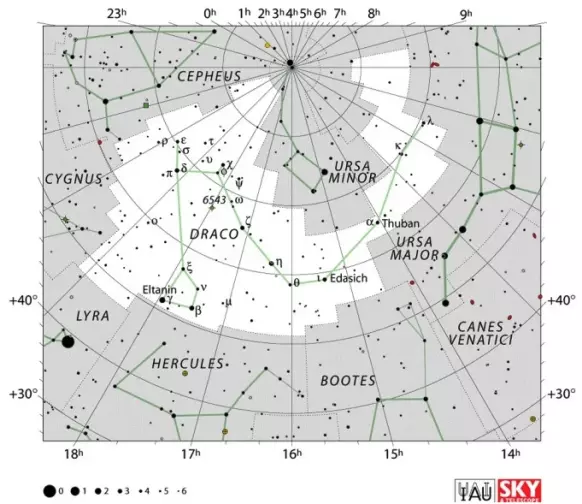
Draco constellation map by IAU and Sky&Telescope magazine
Myth
The constellation Draco is associated with several myths, most frequently with the one about the 12 labours of Heracles, represented by the neighbouring constellation Hercules. In the myth, Draco represents Ladon, the dragon that guarded the golden apples in the gardens of the Hesperides.
The golden apple tree was a wedding present to Hera when she married Zeus. She planted the tree in her garden on Mount Atlas and tasked Atlas’ daughters, the Hesperides, with guarding it. She also placed the dragon Ladon around the tree so that the Hesperides would not pick any apples from it.
In some versions of the myth, Ladon had a hundred heads and was the child of the monster Typhon and Echidna, who was half woman and half serpent.
In others, he was the offspring of two sea deities, Ceto and Phorcys, and there is no mention of the number of heads he had.
As part of his 12 labours, Heracles was asked to steal some golden apples from the tree. He defeated Ladon with his poisoned arrows and took the apples. Saddened by the dragon’s passing, Hera placed its image in the sky among the constellations. Draco is usually depicted coiled around the North Pole, with one foot of Heracles on its head.
In Roman mythology, Draco was one of the Giant Titans who warred with the Olympian gods for ten years. The Titan met his end at the hands of the goddess Minerva and was thrown into the sky, where it froze around the North Pole.
Major stars in Draco
Eltanin – γ Draconis (Gamma Draconis)
Gamma Draconis is the brightest star in Draco. It has an apparent magnitude of 2.3617 and is 154.3 light years distant from the solar system. It is sometimes known as the Zenith Star because it lies close to the zenith point directly overhead in London.
Gamma Draconis is an evolved giant, belonging to the spectral class K5 III. It is 471 times more luminous than the Sun and has 72 percent more mass. It has a companion with a visual magnitude of 13.4, likely a red dwarf that may be a physical companion, not just an optical one.
The star’s traditional name, Eltanin (or Etamin), comes from the Arabic At-Tinnin, which means “the great serpent.”
Eltanin is pretty easy to find in the sky. It lies just north-northwest of Vega, the brightest star in the constellation Lyra.
In about 1.5 million years, the star with pass within 28 light years of Earth, and be the brightest star in the sky, almost as bright as Sirius is today.
Athebyne – η Draconis (Eta Draconis)
Eta Draconis is the second brightest star in Draco. It is a giant star of the spectral type G8 III with an apparent magnitude of 2.73. It is approximately 92.1 light years distant from the solar system. The star’s age is estimated to be 550 million years. Athebyne is 60 times more luminous than the Sun.
Eta Draconis has a companion located 5.1 arc seconds away, a K2 V-class main sequence star with a visual magnitude of 8.8. The physical distance between the stars is at least 140 astronomical units, and the two have an orbital period of at least a millennium.
Rastaban – β Draconis (Beta Draconis)
Beta Draconis, the third brightest star in the constellation, has a visual magnitude of 2.79 and is about 380 light years distant. It has 40 times the radius of the Sun and about six solar masses. It is 950 times more luminous than the Sun.
It is a yellow star of the spectral type G2, halfway between the bright giant and supergiant evolutionary stages (G2 Ib-IIa). The estimated age of Beta Draconis is 67 million years. The bright giant has a dwarf star for a companion, which makes Beta Draconis a binary system.
The star’s traditional name, Rastaban, comes from the Arabic ra’s ath-thu’ban, which means “the head of the serpent.”
Altais – δ Draconis (Delta Draconis)
Delta Draconis is a yellow giant star of the spectral type G9 III with an apparent magnitude of 3.07, about 97.4 light years distant from Earth. The star’s age is estimated at 800 million years. It is 59 times more luminous than the Sun.
The star’s traditional name, Altais, comes from the Arabic Al Tāis, which means “the goat.”
Aldhibah – ζ Draconis (Zeta Draconis)
Zeta Draconis is the fifth brightest star in Draco. It is a giant star of the spectral type B6 III, with an apparent magnitude of 3.17. It is 330 light years distant. The star’s name, Aldhibah, means “the hyenas” in Arabic. It is also sometimes called Nodus III, or the Third Knot, referring to a loop in Draco’s tail.
Zeta Draconis is 2.5 times larger than the Sun and 148 times more luminous.
Edasich – ι Draconis (Iota Draconis)
Iota Draconis is a giant of the spectral type K2 III, approximately 101.2 light years distant from Earth. It has a visual magnitude of 3.290. The star has a planet in its orbit, which was discovered in 2002. This was the first planet discovered to orbit a giant star.
Iota Draconis is slightly more massive than the Sun and has almost 12 times the solar radius. It is 55 times more luminous. The star is believed to have a debris disk surrounding it.
Batentaban Borealis – χ Draconis (Chi Draconis)
Chi Draconis is a star system composed of a yellow-white, class F7V star with a visual magnitude of 3.68, almost twice as luminous as the Sun, and an orange, class K0V star with a magnitude of 5.67. The combined magnitude of the system is 3.570.
The stars form a spectroscopic binary and orbit each other with a period of 280.55 days, with an average separation of just under an astronomical unit. The Chi Draconis system is 26.3 light years distant.
Batentaban Australis – φ Draconis (Phi Draconis)
Phi Draconis has the stellar classification A0sp and is about 300 light years distant. It has an apparent magnitude of 4.2004. It cannot be seen in latitudes south of the Tropic of Capricorn.
Phi Draconis is a multiple star composed of hydrogen fusing dwarfs, with the two brighter components in the system orbiting each other with a period of 307.8 years. The primary component, Phi Draconis A is an unresolvable binary star.
Thuban – α Draconis (Alpha Draconis)
For a star with the Alpha designation, Thuban is pretty inconspicuous: it has an apparent magnitude of 3.6452. A white giant, it belongs to the spectral class A0III and is approximately 303 light years distant. It was the North Pole star from 3942 to 1793 BC. It is 250 times more luminous than the Sun.
Alpha Draconis can be found by following the line from the inner two stars of the Big Dipper, Phecda and Megrez (Gamma and Delta Ursae Majoris), which point in its direction. It is about 15 degrees from Megrez.
Thuban is a double star. The main star has a companion, either a red or white dwarf. The two complete an orbit every 51 days.
The star’s traditional name comes from the Arabic thuʿbān, which means “the snake.”
Grumium – ξ Draconis (Xi Draconis)
Xi Draconis belongs to the spectral class K2 III and is 112.5 light years distant. It has an apparent magnitude of 3.75.
Gianfar (Giausar) – λ Draconis (Lambda Draconis)
Lambda Draconis is a M0 class star 334 light years away, with an apparent magnitude of 4.1.
Tyl – ε Draconis (Epsilon Draconis)
Tyl is a yellow giant of the spectral type G8III, approximately 148 light years distant. It has a visual magnitude of 3.9974. It is a relatively young star for a G class star, with its age estimated at 500 million years.
Epsilon Draconis is 60 times more luminous than the Sun. It takes the star about 420 days to make a complete revolution; its rotational velocity is 1.2 km/s. The main star has a companion, a class K5 orange dwarf with a visual magnitude of 7.3, located 3.2 arc seconds away.
Shǎowèi – κ Draconis (Kappa Draconis)
Kappa Draconis is a blue giant belonging to the spectral class B6 IIIe, with a visual magnitude of 3.82. It is approximately 490 light years distant. The star is about five times more massive than the Sun and 1400 times more luminous.
Kappa Draconis is believed to be entering its red giant stage. It was the closest visible star to the North Pole from 1793 to 1000 BC, but wasn’t considered the pole star because Kochab, Beta Ursae Minoris, was significantly brighter.
θ Draconis (Theta Draconis)
Theta Draconis is a yellow-white main sequence star of the spectral type F9 V, approximately 68.6 light years away. It is 21 percent more massive than the Sun, has 2.5 times the radius, and is 8.7 times more luminous. It has a visual magnitude of 4.1190.
Theta Draconis is a very close spectroscopic binary star with an orbital period of 3.0708216 days. It is a fast rotator, with a speed of 28 km/s or more at the equator, which means that it completes a rotation in less than 4.5 days. The companion is believed to be an M2 class dwarf.
ο Draconis (Omicron Draconis)
Omicron Draconis is a giant belonging to the spectral class K2 III. It has a visual magnitude of 4.62 and is 322.93 light years distant. It is 269 times brighter than the Sun and has 30 times the radius. It is a spectroscopic binary star.
Omicron Draconis is notable for being the North Pole star of Mercury.
Alsafi – σ Draconis (Sigma Draconis)
Alsafi is a main sequence dwarf belonging to the spectral class G9 V. It has an apparent magnitude of 4.674 and is only 18.77 light years distant from Earth. It is smaller and less massive than the Sun and has only 43 percent of the Sun’s luminosity. In 2007, a companion the size of Jupiter or larger was discovered in the star’s vicinity.
42 Draconis
42 Draconis is a giant star of the spectral type K1.5III approximately 320 light years distant. It has an apparent magnitude of 4.833. In 2009, a super-Jupiter (a gas giant) was discovered in its orbit.
Kuma – ν Draconis (Nu Draconis)
Nu Draconis is a binary star composed of ν1 Draconis and ν2 Draconis, two similar white A-type stars separated by 62 arc seconds. The first component is a hydrogen fusing dwarf of the spectral type A6 and the second component is an A4 class dwarf and has a dimmer, low mass companion that completes an orbit every 38.6 days.
The system has a combined apparent magnitude of 4.13
Alrakis – μ Draconis (Mu Draconis)
Mu Draconis is another double star in Draco. The system is composed of two F7V class stars and has a combined apparent magnitude of 4.92. It is about 85 light years distant.
Science fiction fans will recognize the star by its traditional name, Arrakis (formally Alrakis) from Frank Herbert’s Dune series. The name is derived from the Arabic word al-Raqis, meaning “the dancer.”
26 Draconis
26 Draconis is a triple star system composed of a spectroscopic double star with an orbital period of 76 years and composite spectral classification G0V. The stars belong to the spectral classes F9V and K3V. The third star in the system is a red dwarf of the spectral type M1V, separated from the main pair by 12.2 arc seconds. The three stars share a common proper motion. They are suspected to be members of the Ursa Major Moving Group. The system lies some 46 light years from Earth.
BY Draconis
BY Draconis is another multiple star in Draco constellation. It is composed of a close binary star with components orbiting each other every 5.98 days. The star serves as a prototype of a class of variable stars called BY Draconis variables. Their variability is a result of activity in their photosphere called starspots and the rapid rotation that changes the viewing angle of the activity when the stars are observed from Earth.
The two stars are believed to be pre-main sequence, still in the process of collapsing.
The third star in the system is separated from the main pair by 17 seconds of arc. It is a red dwarf belonging to the spectral class M5. The system may have a fourth component, but this has not been confirmed.
Struve 2398 – HD 173739/HD 173740 (Gliese 725)
Struve 2398 is another double star, one composed of two red dwarfs (class M3 V and M3.5 V) both of which show variability common to flare stars. The stars’ orbital period is 295 years and they are separated by 56 astronomical units on average. They are a known source of X-rays.
Struve 2398 is only 11.52 light years distant. The stars’ apparent magnitudes are 8.94 and 9.70.
Kepler-10
Kepler-10 is a star very similar to the Sun approximately 564 light years away. It was the first star identified by the Kepler spacecraft as a possible host to a small transiting exoplanet. The star has at least two planets in its system. The first, Kepler-10b, is a rocky planet discovered in January 2011. It orbits the star with a period of 0.8 days. The second one, Kepler-10c, was discovered in May 2011. It has an orbital period of 42.3 days.
Kepler-10 is a G-class star about 11.9 billion years old, which is 2.6 times the age of the Sun. It has an apparent magnitude of 10.96 and cannot be seen without optical aid.
GD 356
GD 356 is a white dwarf of the spectral type DC7, approximately 65 light years distant. It has a visual magnitude of 15.06 and cannot be seen without a telescope. Its estimated age is 2.1 billion years.
The star’s spectral classification means that it has a cool, helium rich atmosphere. It is also classified as a high field magnetic white dwarf (HFMWD).
Deep sky objects in Draco
Cat’s Eye Nebula – NGC 6543 (Caldwell 6)
The Cat’s Eye Nebula is a planetary nebula approximately 3300 light years distant from Earth. It has a visual magnitude of 9.8. It is one of the most complex nebulae ever discovered. It was formed about a thousand years ago, when a bright hot star lost its outer envelope in the red giant phase. The central star has the stellar classification O7 and is about 10,000 times more luminous than the Sun.
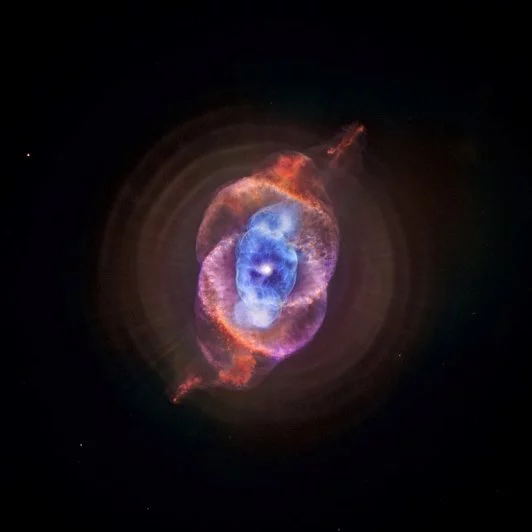
A composite image of data from NASA’s Chandra X-ray Observatory (blue) and Hubble Space Telescope (red and purple) of NGC 6543 shows a phase that Sun-like stars undergo at the end of their lives. Material from the outer layers of the star in the Cat’s Eye is flying away at about 4 million miles per hour. A hot core is left behind that eventually collapses to become a white dwarf star. The Chandra data reveal that the central star in NGC 6543 is surrounded by a cloud of multi-million-degree gas. Image: Smithsonian Institution, X-ray: NASA/CXC/SAO; Optical: NASA/STScI
Because the structure of the nebula is so complex, the central star is suspected to be a binary star. As a result of a strong stellar wind, it is losing about 20 trillion tons of mass per second and is currently believed to be only slightly more massive than the Sun.
The nebula was discovered by William Herschel in February 1786. It was the first planetary nebula to be observed with a spectroscope, by William Huggins in August 1864.
Spindle Galaxy – Messier 102 – NGC 5866
The Spindle Galaxy is a spiral or lenticular galaxy discovered in 1781 by either Pierre Méchain or Charles Messier and then independently discovered by William Herschel in 1788. It has an apparent magnitude of 10.7 and is about 50 million light years distant.
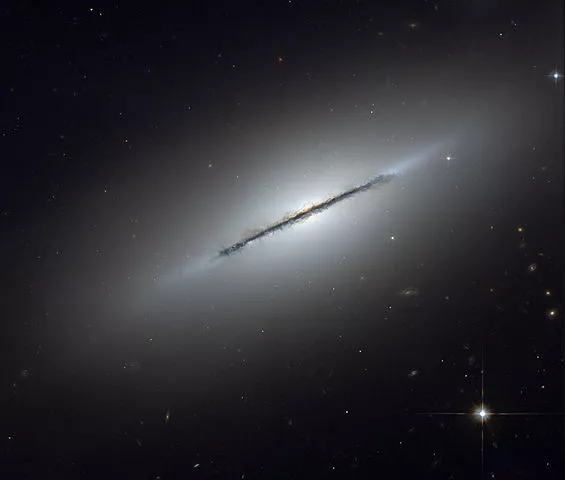
This is a unique view of the disk galaxy NGC 5866 tilted nearly edge-on to our line-of-sight. Hubble’s sharp vision reveals a crisp dust lane dividing the galaxy into two halves. The image highlights the galaxy’s structure: a subtle, reddish bulge surrounding a bright nucleus, a blue disk of stars running parallel to the dust lane, and a transparent outer halo. NGC 5866 is a disk galaxy of type “S0” (pronounced s-zero). Viewed face on, it would look like a smooth, flat disk with little spiral structure. It remains in the spiral category because of the flatness of the main disk of stars as opposed to the more spherically rotund (or ellipsoidal) class of galaxies called “ellipticals.” Such S0 galaxies, with disks like spirals and large bulges like ellipticals, are called ‘lenticular’ galaxies. Image: NASA and ESA
It is one of the brightest galaxies in the NGC 5866 group, which also contains NGC 5879 and NGC 5907, two spiral galaxies discovered by William Herschel.
The galaxy is notable for its extended disk of dust, seen exactly edge-on. The disk, which might contain a ring-like structure, is an unusual feature for a lenticular galaxy. The galaxy might also be a spiral galaxy, in which case the dust disk would not be unusual.
Draco Dwarf Galaxy
The Draco Dwarf Galaxy is a spheroidal galaxy in Draco. It has a visual magnitude of 10.9 and is 260,000 light years distant. It belongs to the Local Group and is a satellite galaxy of the Milky Way, one of the faintest ones.
The galaxy was discovered by the American astronomer Albert George Wilson in 1954. It contains five carbon stars, four suspected asymptotic giant branch (AGB) stars, a number of red giant branch (RGB) stars, and more than 260 variables, all but five of which are of the RR Lyrae type.
The galaxy is believed to contain large amounts of dark matter.
Abell 2218
Abell 2218 is a galaxy cluster in Draco, about 2.345 million light years distant. It contains thousands of galaxies and a mass equal to 10,000 galaxies.
The cluster was used as a gravitational lens to find the most distant known object in the universe, a 13 billion year-old galaxy that is seen from Earth as it appeared only 750 million years after the Big Bang.
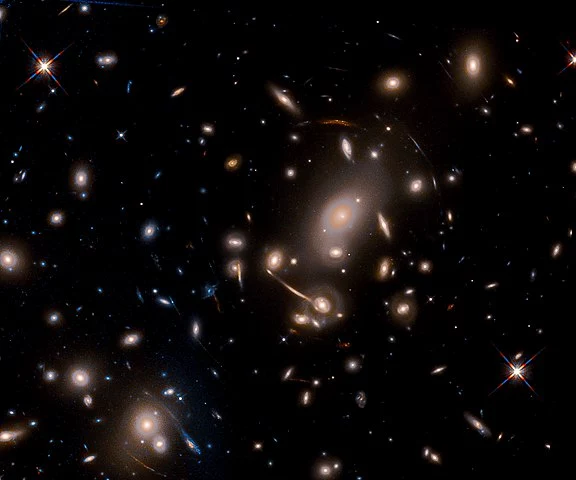
Abell 2218, image: NASA/ESA/Kevin M. Gill
Gravitational lensing refers to the phenomenon of the light of the source being bent (or lensed) as it travels toward the person observing it. In this case, it means that spacetime around Abell 2218 is curved because the cluster is such a massive object and that rays of light coming from a background galaxy get bent as they pass through the spacetime. As a result the image of the background galaxy (or any other background object) can be magnified and distorted. The lensing effect allows astronomers to study objects that are even more distant than the cluster.
Tadpole Galaxy – Arp 188
The Tadpole Galaxy is a disrupted (collided) barred spiral galaxy in Draco. It has a visual magnitude of 14.4 and is about 400 million light years distant from the solar system. It is notable for its enormous trail of stars, about 280 thousand light years long. The galaxy contains many clusters of massive, bright blue stars.
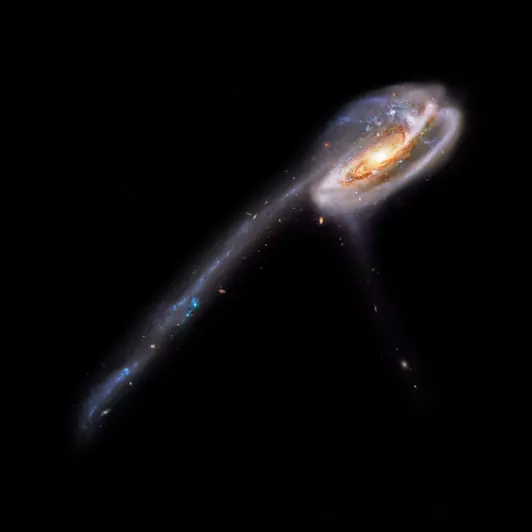
The Tadpole Galaxy recorded with the Hubble Space Telescope’s Advanced Camera for Surveys. Image processed and rendered by by Pablo Carlos Budassi (CC BY-SA 4.0)
The disrupted shape of the galaxy is believed to be a result of gravitational interaction with a smaller, more compact galaxy, which drew out the stars, dust and gas out of the main body of Arp 188.
The smaller galaxy is believed to be located about 300 thousand light years behind the Tadpole Galaxy and can be seen in the picture.
Q1634+706
Q1634+706 is a quasar located in Draco constellation. It is notable for being the most distant object in the sky that can be seen in an amateur telescope. It has an apparent magnitude of 14.4 and is roughly 12.9 billion light years distant.
NGC 6340
NGC 6340 is a spiral galaxy in Draco. It has a visual magnitude of 11.9 and is approximately 52 million light years distant.
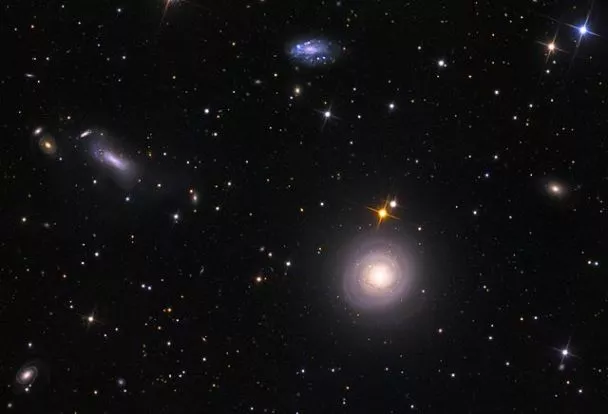
NGC 6340, image: Adam Block/Mount Lemmon SkyCenter/University of Arizona
NGC 5879
NGC 5879 is a spiral galaxy that is a member of the NGC 5866 Group. It was discovered by William Herschel in 1788. It has an apparent magnitude of 12.4.
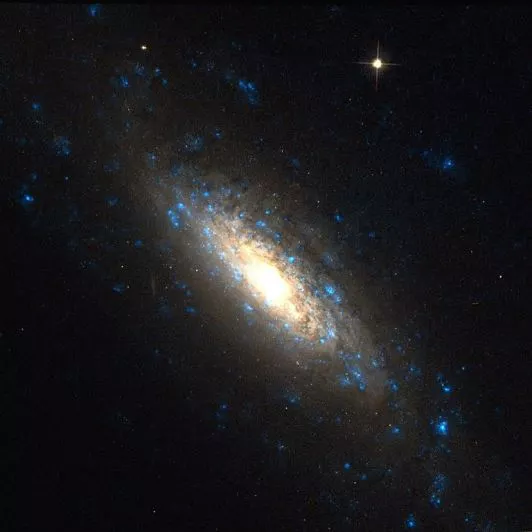
NGC 5879, image NASA/ESA
NGC 4319 and Markarian 205
NGC 4319 is a barred spiral galaxy in Draco. It has a visual magnitude of 12.8 and is approximately 92 million light years distant. Markarian 205 is a quasar presumably located in the vicinity of the galaxy.
In 1971, a luminous bridge was discovered between the two objects using a 5-meter telescope, but NASA disputed the existence of the bridge in 2002 by posting a photo taken by the Hubble Space Telescope.
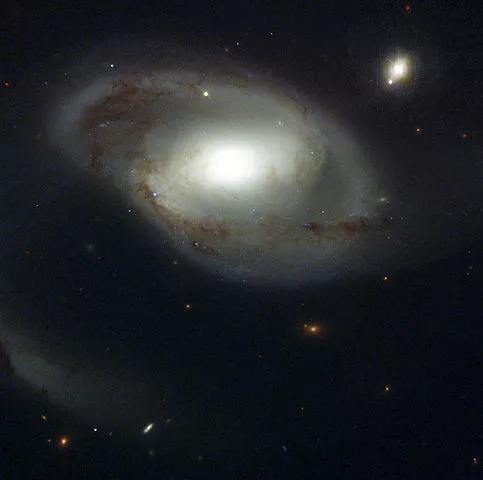
Hubble Space Telescope picture of the barred spiral galaxy NGC 4319 and the quasar Markarian 205 (Mrk 205). NGC 4319 lies at a distance of roughly 80 million light years away from Earth, while Mrk 205 lies much farther away at a distance of 1 billion light years. Mrk 205 is still relatively close to Earth as many quasars reside at much greater distances. Image: NASA/ESA and The Hubble Heritage Team (STScI/AURA)
Oddly, the photo does in fact show the bridge, and this has been a cause of debate and controversy for years now because it contradicts the hypothesis of an expanding universe, as it invalidates the belief that redshift is always a measure of velocity and distance.
The two objects have very different redshifts. Markarian 205 is believed to be almost 1.2 billion light years from Earth, while NGC 4319 is significantly closer.
If the bridge exists, and photographs show that it does, the two objects could not possibly be that far from each other.
NGC 4236
NGC 4236 is a barred spiral galaxy with a visual magnitude of 10.5. It is a member of the M81 Group, which also contains the famous Bode’s Galaxy (Messier 81) and the Cigar Galaxy (Messier 82), both of which are located in the constellation Ursa Major.
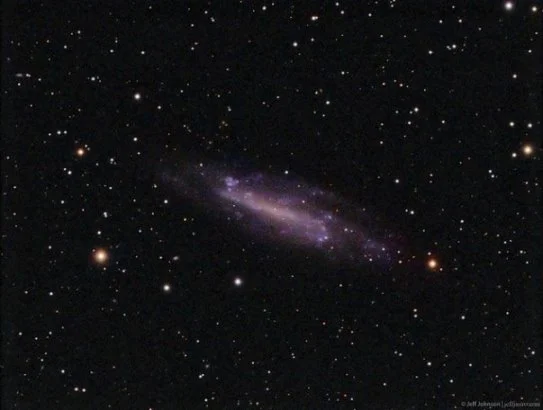
NGC 4236, image: Jeffrey O. Johnson at jeffastro.com, (CC BY-SA 4.0)
NGC 6503
NGC 6503 is a dwarf spiral galaxy in Draco. It has an apparent magnitude of 10.2 and is approximately 17 million light years distant. It was discovered by the German astronomer Arthur Auwers in July 1854.
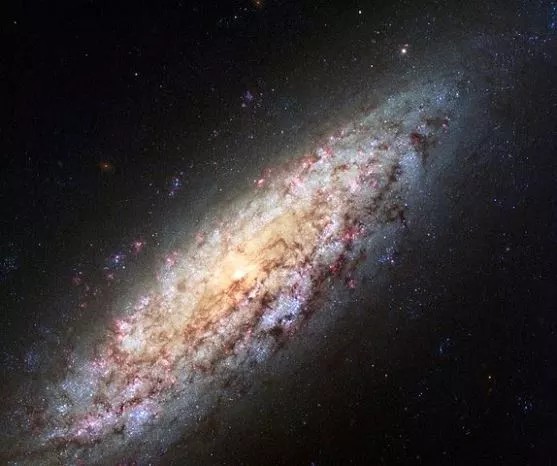
This Hubble Space Telescope image shows NGC 6503 in striking detail and with a rich set of colors. Bright red patches of gas can be seen scattered through its swirling spiral arms, mixed with bright blue regions that contain newly forming stars. Dark brown dust lanes snake across the galaxy’s bright arms and center, giving it a mottled appearance. Image: NASA, ESA, D. Calzetti (University of Massachusetts), H. Ford (Johns Hopkins University), and the Hubble Heritage Team
The galaxy’s structure is similar to that of the Milky Way, but it is only about a third of the size of our galaxy.
NGC 6503 lies in the region of space known as the Local Void, which is a large, empty region of space next to the Local Group of galaxies. The void is between 30 and 150 million light years in diameter. It was discovered by astronomers Brent Tully and Rick Fisher in 1987.
NGC 5949
NGC 5949 is a dwarf galaxy located at an approximate distance of 44 million light years from Earth. It has an apparent magnitude of 12.70. The galaxy was discovered by William Herschel on November 28, 1801.
NGC 5949 has a mass only about a hundredth that of the Milky Way and contains a relatively small number of stars, which is why it is classified as a dwarf. However, it also has loosely bound spiral arms that place it in the category of barred spiral galaxies.
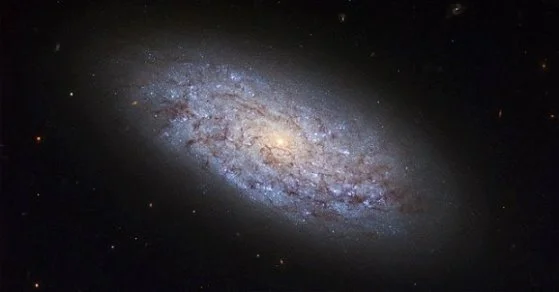
The subject of this Hubble Space Telescope image is a dwarf galaxy named NGC 5949. Thanks to its proximity to Earth — it sits at a distance of around 44 million light-years from us, placing it within the Milky Way’s cosmic neighborhood — NGC 5949 is a perfect target for astronomers to study dwarf galaxies. With a mass of about a hundredth that of the Milky Way, NGC 5949 is a relatively bulky example of a dwarf galaxy. Its classification as a dwarf is due to its relatively small number of constituent stars, but the galaxy’s loosely bound spiral arms also place it in the category of barred spirals. This structure is just visible in this image, which shows the galaxy as a bright yet ill-defined pinwheel. Despite its small proportions, NGC 5949’s proximity has meant that its light can be picked up by fairly small telescopes, something that facilitated its discovery by the astronomer William Herschel in 1801. Astronomers have run into several cosmological quandaries when it comes to dwarf galaxies like NGC 5949. For example, the distribution of dark matter within dwarfs is quite puzzling (the “cuspy halo” problem), and our simulations of the universe predict that there should be many more dwarf galaxies than we see around us (the “missing satellites” problem). Image: NASA
PGC 39058
PGC 39058 is a dwarf galaxy located in Draco. It is approximately 14 million light years distant and difficult to observe because it is obscured by a bright star in front of it.
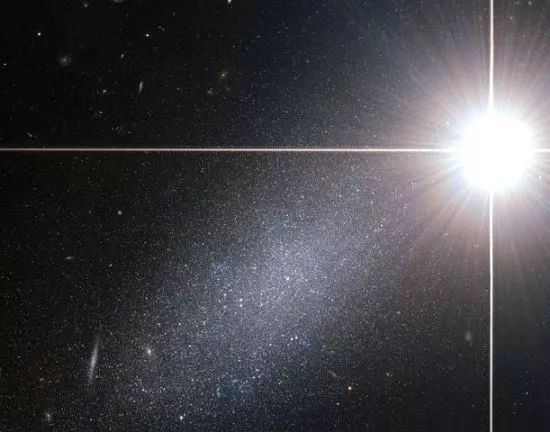
Astronomers are used to encountering challenges in their work, but studying the prosaically-named galaxy PGC 39058 proves more difficult than usual. Due to a stroke of bad luck, a bright star happens to lie between the galaxy and the Earth, meaning our view is partly obscured by the glare of the star. The astounding image from the NASA/ESA Hubble Space Telescope shows the nearby star easily outshining the more distant galaxy PGC 39058. The galaxy is about 14 million light-years away and contains millions of stars — many of them not unlike the bright star in the foreground. Image: ESA, Hubble & NASA